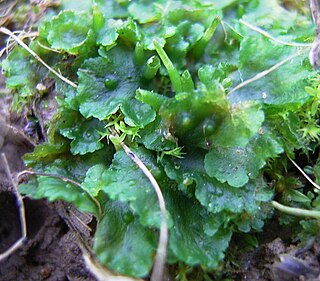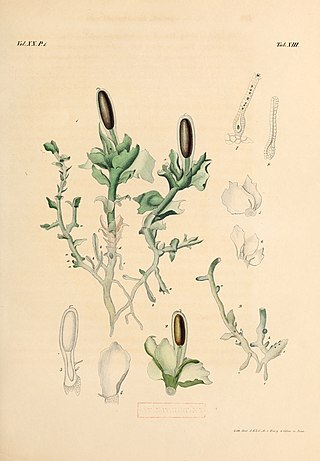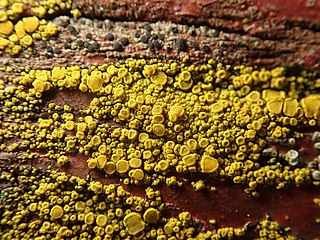
The Marchantiophyta are a division of non-vascular land plants commonly referred to as hepatics or liverworts. Like mosses and hornworts, they have a gametophyte-dominant life cycle, in which cells of the plant carry only a single set of genetic information.

Hornworts are a group of non-vascular Embryophytes constituting the division Anthocerotophyta. The common name refers to the elongated horn-like structure, which is the sporophyte. As in mosses and liverworts, hornworts have a gametophyte-dominant life cycle, in which cells of the plant carry only a single set of genetic information; the flattened, green plant body of a hornwort is the gametophyte stage of the plant.

Dendroceros is a genus of hornworts in the family Dendrocerotaceae. The genus contains about 51 species native to tropical and sub-tropical regions of the world.

Megaceros is a genus of hornworts in the family Dendrocerotaceae. The genus is found in the Old World tropics of east Asia and Australia. Its name means 'big horn', and refers both to the exceptionally large size of the gametophyte thallus and to the large, horn-shaped sporophyte that the plants produce. Many species have a branching thallus that is more than two centimeters wide. The gametophytes are monoicous.
Notothylas is a genus of hornworts in the family Notothyladaceae. The genus is found globally, but is usually overlooked. It is the smallest of all the hornworts, with a yellow-green gametophyte thallus that is seldom more than a centimeter in diameter, and usually much smaller.

The Notothyladaceae is the only family of hornworts in the order Notothyladales.
Folioceros is a genus of hornworts in the family Anthocerotaceae. The genus is common locally in the tropical and subtropical regions of Asia, growing on moist rocks, in fallow fields, and near waterfalls. It has a yellow-green gametophyte thallus that is crispy and translucent, with short branchings that are almost pinnate. Plants are usually less than a centimeter wide and 3 centimeters long. They may be monoicous or dioicous.

Haplomitriopsida is a newly recognized class of liverworts comprising fifteen species in three genera. Recent cladistic analyses of nuclear, mitochondrial, and plastid gene sequences place this monophyletic group as the basal sister group to all other liverworts. The group thus provides a unique insight into the early evolution of liverworts in particular and of land plants in general.
Leiosporoceros dussii is the only species in the hornwort genus Leiosporoceros. The species is placed in a separate family, order, and class for being "genetically and morphologically distinct from all other hornwort lineages." Cladistic analysis of genetic data supports a position at the very base of the hornwort clade. Physical characteristics that distinguish the group include unusually small spores that are monolete and unornamented. Additionally, there are unique strands of Nostoc (cyanobacteria) that grow inside the plant parallel with its direction of growth. Unlike other hornworts with symbiotic cyanobacteria that enters through mucilage clefts, the mucilage clefts in Leiosporoceros is only present in young plants and then closes permanently once the cyanobacterial colonies have been established. Also mycorrhiza and pyrenoids are absent. Male plants have been found in Panama.

Candelariella is a genus of bright yellow, ocher, or greenish yellow crustose or squamulose lichens in the family Candelariaceae. Members of the genus are commonly called eggyolk lichens, goldspeck lichens, or yolk lichens. The genus was circumscribed in 1894 by Swiss lichenologist Johannes Müller Argoviensis, with Candelariella vitellina assigned as the type species.
Makinoa crispata is the only species of liverwort in the genus Makinoa and family Makinoaceae. The genus Verdoornia was formerly included in this family, but has been transferred to the family Aneuraceae on the basis of recent cladistic analysis of genetic sequences.

Pleurozia is the only genus of liverworts in the family Pleuroziaceae, which is now classified in its own order Pleuroziales, but was previously included in a broader circumscription of the Jungermanniales. The genus includes twelve species, and as a whole is both physically distinctive and widely distributed.

The Anthocerotaceae is the only family of hornworts in the order Anthocerotales.

The Dendrocerotaceae is the only family of hornworts in the order Dendrocerotales.
Phymatoceros is the only genus in the hornwort family Phymatocerotaceae and order Phymatocerotales. It includes only two species.
Phaeomegaceros is a genus of hornworts in the family Dendrocerotaceae. It includes seven species.

Casterlorum is a genus of fossil with controversial interpretation from the Middle Ordovician Douglas Lake Member of the Lenoir Limestone from Douglas Dam Tennessee The genus was named in honor of Ken Caster.
John Walter Thomson Jr. (1913–2009) was a Scottish-born American botanist and lichenologist, sometimes referred to as the "Dean of North American Lichens".
Robert "Bob" Shaw Egan is a botanist and lichenologist, specializing in the family Parmeliaceae. He was the president of the American Bryological and Lichenological Society from 1999 to 2001.

Robert Lücking is a German lichenologist. He earned his master's and PhD from the University of Ulm, focusing on the taxonomy, ecology, and biodiversity of foliicolous lichens. He has received numerous awards for his work, including the Mason E. Hale award for his doctoral thesis, the Augustin Pyramus de Candolle prize for his monograph, and the Tuckerman Award twice for his publications in The Bryologist. Since 2015, he has been serving as the curator of lichens, fungi, and bryophytes at the Berlin Botanical Garden and Botanical Museum, and several lichen species and a genus have been named in his honour.










